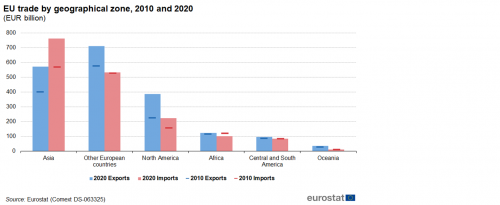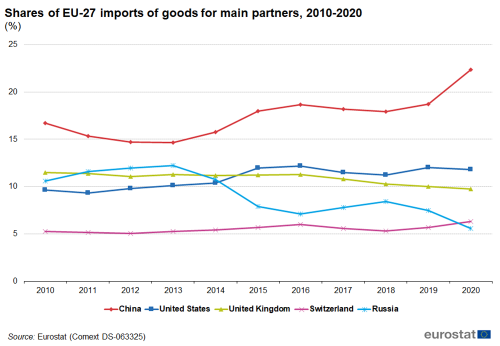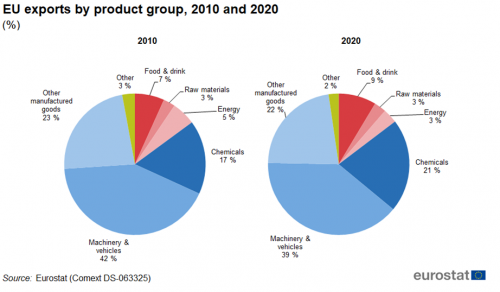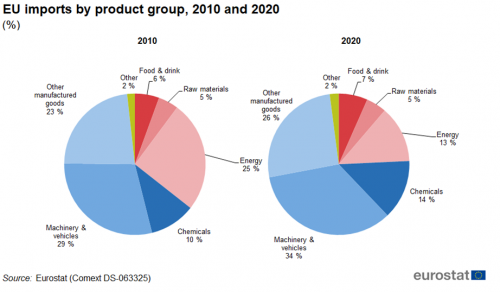Archive:Extra-EU trade in goods
Data from March 2020.
Planned update: March 2021.
Highlights
EU exports fell less than imports and consequently the trade balance increased from EUR + 192 billion in 2019 to EUR 217 billion in 2020.
The main destination for EU exports in 2020 were other European countries accounting for j37 % of the total, followed by Asia (30 %) and North America (20 %).
International trade - especially the size and evolution of imports and exports - is an important indicator of the performance of the European Union (EU) economy, showing how it interacts with other countries and its position.
This article takes a close look at recent trends in imports and exports, focusing on extra-EU trade, the main trading partners, and the most traded products.
This article is part of an online publication providing recent statistics on international trade in goods, covering information on the EU's main partners, main products traded, specific characteristics of trade as well as background information.
Full article
Evolution of extra-EU trade
Due to the COVID-19 pandemic extra-EU trade fell considerably between 2019 and 2020 (see Figure 1). Exports dropped by EUR 200 billion while imports fell by EUR 226 billion. The net effect was an increase in the trade surplus from EUR 192 billion in 2019 to EUR 217 billion in 2020. However, over a longer period, between 2010 and 2020 both imports and exports increased. The average annual growth rate of extra-EU trade was (2.3 %) with exports (3.0 %) growing faster than imports(1.5 %).
In 2020, about 44 % of EU imports came from Asian countries while other European countries accounted for 31 % and North America for 13 % (see Figure 2). The main destination for EU exports in 2020 were other European countries with 37 % of the total exports, followed by Asia (30 %) and North America (20 %). The EU had a considerable deficit in trade with Asian countries (- EUR 188 billion), while there were large surpluses in trade with other European countries (+ EUR 177 billion) and North America (+ EUR 164 billion).
Main EU partners
In 2020, the USA was the EU’s major trading partner in exports (see Figure 3). Between 2010 and 2019 its share grew from 14,1 % to 18,1 %, an increase of 4.0 percentage points (p.p.) China's share in extra-EU exports grew by 3.2 p.p. Swiss exports in this period were relatively stable, growing by only half a percentage point. Russia and the United Kingdom saw their shares decline by 1.7 p.p. and 1.6 p.p. respectively
The EU's main import partner is China (see Figure 4). Its share increased from 16.7 % of total extra-EU imports in 2010 to 22.4 % in 2020, an increase of 5.7 p.p. The shares of the United States and Switzerland also grew, by 2.2 p.p. and 1.1 p.p. respectively while the United Kingdom (-1.7 p.p.) and Russia (-5.0 p.p.) both saw their shares decrease.
The EU trade surplus with the United States grew from EUR 61 billion in 2010 to a record high of EUR 150 billion in 2020. (see Figure 5). The EU also had trade surpluses with the United Kingdom (EUR 110 billion) and Switzerland (EUR 34 billion). With Russia the EU had a trade deficit (EUR 16 billion in 2019) mainly due to the imports of energy products. The trade deficit with China was EUR 181 billion in 2020, mostly due to trade surpluses for manufactured goods.
EU trade by main product groups
Figures 6 and 7 show exports and imports by product group. The primary products (food and drink, raw materials and energy) are shown in red colours while the manufactured products (chemicals, machinery and vehicles and other manufactured goods) are shown in blue colours.
The EU exports mainly manufactured products: both in 2010 and 2020 their share more than 80 % of total EU exports (see Figure 6). Within this group, machinery and vehicles made up 42 % of the total exports in 2010, slightly falling to 39 % in 2020. In 2010, other manufactured goods accounted for 22 % and chemicals accounted for 21 %. Primary products accounted for 15 % of total exports. This category is made up of food and drink (9 %), energy products and raw materials (both 3 %).
The majority of EU imports are also manufactured goods (see Figure 7). Their share in total EU imports increased from 63 % in 2010 to 74 % in 2020. The breakdown diverges from exports: machinery and vehicles (34 %) and chemical products (14 %) have smaller shares while the share of other manufactured goods (26 %) is slightly higher that in exports. The share of energy in imports has significantly decreased in recent years. In 2010 it accounted for 25 % of imports, while in 2020 the share had fallen to 13 %. This decrease is closely related to the fall of the oil price in this period.
Source data for tables and graphs
Data sources
EU data is taken from Eurostat's COMEXT database. COMEXT is the reference database for international trade in goods. It provides access not only to both recent and historical data from the EU Member States but also to statistics of a significant number of third countries. International trade aggregated and detailed statistics disseminated via the Eurostat website are compiled from COMEXT data according to a monthly process.
Data are collected by the competent national authorities of the Member States and compiled according to a harmonised methodology established by EU regulations before transmission to Eurostat. For extra-EU trade, the statistical information is mainly provided by the traders on the basis of customs declarations.
EU data are compiled according to Community guidelines and may, therefore, differ from national data published by the Member States. Statistics on extra-EU trade are calculated as the sum of trade of each of the 27 EU Member States with countries outside the EU. In other words, the EU is considered as a single trading entity and trade flows are measured into and out of the area, but not within it.
The United Kingdom is considered as an extra-EU partner country for the EU for the whole period covered by this article. However, the United Kingdom was still part of the internal market until the end of the transitory period (31 December 2020), meaning that data on trade with the United Kingdom are still based on statistical concepts applicable to trade between the EU Member States. Consequently, while imports from any other extra-EU trade partner are grouped by country of origin, the United Kingdom data reflect the country of consignment. In practice this means that the goods imported by the EU from the United Kingdom were physically transported from the United Kingdom but part of these goods could have been of other origin than the United Kingdom. For this reason, data on trade with the United Kingdom are not fully comparable with data on trade with other extra-EU trade partners.
Unit of measure Trade values are expressed in billions (109) of euros. They correspond to the statistical value, i.e. to the amount which would be invoiced in case of sale or purchase at the national border of the reporting country. It is called a FOB value (free on board) for exports and a CIF value (cost, insurance, freight) for imports.
Context
Europe is the world's largest exporter of manufactured goods and services, and is itself the biggest export market for around 80 countries. Trade is an important indicator of Europe's prosperity and place in the world, and the bloc has become deeply integrated into global markets both for the products it sources and the exports it sells.
Because the 27 Member States of the European Union share a single market and a single external border, they also have a single trade policy. Both in the World Trade Organization, where the rules of international trade are agreed and enforced, and with individual trading partners, EU Member States speak and negotiate collectively.
Direct access to
- International trade data (t_ext)
- International trade long-term indicators (t_ext_lti)
- International trade short-term indicators (t_ext_sti)
- International trade data (ext)
- International trade long-term indicators (ext_lti)
- International trade short-term indicators (ext_sti)
- International trade detailed data (detail)
- International trade in goods statistics - background
- International trade in goods (ESMS metadata file — ext_go_agg_esms)
- User guide on European statistics on international trade in goods
- Regulation (EC) No 471/2009 of 6 May 2009 on Community statistics relating to external trade with non-member countries
- Summaries of EU Legislation: Extrastat: statistics relating to trade with non-EU countries
- Regulation (EU) No 92/2010 of 2 February 2010 implementing Regulation (EC) No 471/2009, as regards data exchange between customs authorities and national statistical authorities, compilation of statistics and quality assessment
- Regulation (EU) No 113/2010 of 9 February 2010 implementing Regulation (EC) No 471/2009 , as regards trade coverage, definition of the data, compilation of statistics on trade by business characteristics and by invoicing currency, and specific goods or movements.






